Assessing the Robustness of Ozone Chemical Regimes to Chemistry-Transport Model Configurations
Abstract
:1. Introduction
2. Methodology
2.1. The CHIMERE (CTM) Model
2.2. Emissions
2.3. The ACT Model
2.4. Numerical Experiment Description
3. Impact of Increasing Horizontal Resolution
3.1. ACT Model Design
- -
- Lyon (FR20062): The station itself is an urban station, rather influenced by traffic emissions but the area around Lyon is also known to be an area with high pollutant emissions from the industrial sector. Lyon is in the Rhône valley with a continental climate;
- -
- Bourgoin-Jallieu (BJ—FR27007): This station is a suburban-type station. The emissions of ozone precursors are less important than in Lyon and because of the wind blowing from the Rhône valley towards the south, it is often found in the plume of pollutants coming from Lyon;
- -
- Marseille (FR03043): The station itself is an urban station, rather influenced by traffic emissions. Emissions from the maritime sector are also important in this city. At the seaside, the influence of the sea breeze is important;
- -
- Fos-sur-mer (FR02004): This station is located at the Etang-de-Berre, which is an important industrial area, mainly due to the refineries and petrochemical complexes located around the lagoon;
- -
- OHP (Observatoire de Haute Provence) (FR24039): This station is of rural type, far from all important emission sources but regularly downstream of the plumes of the Aix-Marseille area. Pollution plumes produce ozone when they move away from emission sources (and the ozone is no longer titrated by too much NO), a production also fueled by high levels of biogenic VOCs in the Provencal hinterland. As a result, significant levels of ozone are measured in OHP.
3.2. Impact of the Resolution on Modelled Ozone Concentrations and Evaluation against Observations
3.3. Impact of the Model Resolution on Ozone Response to Emission Reductions
3.3.1. Response to 60% Reduction in Traffic Emissions
3.3.2. O3 Response to the Whole Range of Emission Reductions
- -
- Isopleths, based on the same principle as the [35] isopleths, but with the reductions in road transport and industrial emissions on the x-axis and y-axis instead of NOx and NMVOC concentrations (see also Section 2.3 in [13] for more details). For each city in the study, these isopleths were established for various O3 indicators representative of the daily max ozone averaged over different periods (annual, summer, winter, sum of value >70 µg/m3 to represent SOMO35 or percentile 93.15 to represent the EU target value);
- -
- For a comparison of all cities, the total ozone changes for each day obtained by any combination of traffic and industrial emission reductions in a city were also represented by a boxplot.
Percentile 72.8 Results
- -
- In Fos-sur-mer, increasing the resolution of the model leads to (1) a decrease in the initial simulated ozone concentrations (represented as a triangle) and (2) a reduction in the ozone response: reductions in traffic and industrial precursor emissions are less effective to reduce ozone 72.8 percentile (Figure 5b) and can even be counterproductive (positive relative difference, i.e., increase of ozone compared to initial values represented as a triangle). As explained earlier, high NOx emissions unaccompanied by high NMVOC levels leads to O3 destruction which may not be offset by the increase in ozone production, resulting in a net O3 destruction. A higher resolution leads to an increase in NOx near the sources and, therefore, an increase in O3 destruction. In Fos-sur-mer, the increase in ozone destruction caused by the spatial concentration of NOx emissions results in both lower initial concentrations and lower ozone decreases when emissions are reduced.
- -
- In Lyon, NOx emissions are more concentrated with a higher resolution. This leads to a small reduction in the ozone response when a higher resolution is used (for the same % of reduction, emission cuts are slightly less effective) but it does not result in lower initial concentrations.
- -
- In Marseille and Bourgoin-Jailleu, the maximum reduction obtained for a 100% reduction in both traffic and industrial emissions is higher when increasing the resolution. Initial O3 P72.8 values are also significantly higher with SEFRA04 by approximately 10 µg/m3 in both areas. Here, when NOx emissions start to decrease, the same behaviour as for Lyon was simulated: a greater reduction in ozone destruction with the 4 km resolution (see B-J isopleths in Figure 4). However, after a certain reduction in NOx, the behaviour reverses and a drop in ozone production (downwind production that is boosted with the 4 km resolution) dominates. This results in median reductions that are close to the two different resolutions, but strong cuts in emissions have a greater impact on ozone with the finest resolution allowing a greater maximum relative reduction (Figure 5b).
- -
- In OHP, as in Marseille and B-J, increasing the resolution leads to a significant increase in O3 initial value. In OHP, which is located in a rural area, high ozone levels are fed by pollution plumes from Marseille and the Etang-de-Berre (where Fos-sur-mer is located). Increasing the resolution has the effect of spreading these plumes less as they move around, therefore, favouring the production of ozone in rural areas. The extent of ozone reductions achieved by cutting emissions is slightly less with the higher resolution.
Summer Average of Daily O3
Focus on Ozone Peaks
4. Impact of the Boundary Conditions (BC-EUREF vs. BC-EURED)
5. Impact of Changing Model and Emissions Parametrisation on the Ozone Response to Emission Reductions
5.1. Impact on Modelled Ozone Concentrations in the Reference Simulation
5.2. Impact on Ozone Response to Emission Reductions
- Titration regime (complete or partial): reductions in emissions (IND or TRA or both) lead to an increase in the summer average of ozone daily maxima for more than half of the emission reduction pairs. This can be the case for any reduction (complete titration regime) or only for some part of the IND:TRA reduction space (partial titration regime);
- TRA sensitive: reductions in road transport emissions produce a greater reduction in the summer average of ozone daily maxima than for reductions in industrial emissions;
- IND sensitive: reductions in industrial emissions produce a greater reduction in the summer average of ozone daily maxima than reductions in road transport emissions;
- TRA and IND sensitive: road transport and industrial emission reductions have a similar impact on the summer average of ozone daily maxima;
- Change in regime: a decrease in O3 metrics is the dominant reaction to emission decreases but an increase in the summer average of ozone daily maxima occurs in a small part of the IND:TRA reduction space;
- Change in sensitivity: There is a clear shift from a regime sensitive to road transport emission reductions to a regime sensitive to industrial emission reductions (or the reverse). This case was not encountered in the cities and over the period selected.
6. Discussion and Conclusions
- -
- The main impact of increasing the resolution of the model is to concentrate emissions close to the emission release areas. This leads to an increase in ozone precursor emissions and, therefore, an increase in ozone production but also to higher consumption of ozone by reaction with NO (more titration impact). Therefore, depending on the production/destruction balance, the impact will be different. When the ozone indicator is representative of daily ozone peaks, increasing the resolution will have an impact on the ozone simulated in the reference simulation (without emission reductions) but relatively little impact on the ozone response to a given emission reduction. On the other hand, when focusing on the average ozone value (i.e., daily average ozone over the summer period), the resolution has a strong impact both on the initial ozone concentration values (without emission reductions) and on the ozone response. For the daily average indicator, we observed a switch to a titration regime for all the areas with significant NOx emissions and a reduction in the amplitude of the ozone response elsewhere;
- -
- In the domain of interest in this study (i.e., the south of France), the impact of pollution imported from outside the simulation domain was studied by comparing simulations for which emission reductions were limited to the domain or applied to the whole of Europe. The results show that this external pollution did not affect the chemical regime which remains unchanged in response to changing boundary conditions. The first lever for action on ozone peaks remains the reduction of local and regional emissions, but in order to achieve higher levels of reduction, it is necessary to act at the European level to reduce ozone imports. However, this ozone import can only be effectively reduced by high levels of emission reduction (>70%). With such emission reductions, ozone import can be almost as effective as regional reductions to reduce ozone peaks. It is important to note that the study area (south-east France) is a zone with high ozone precursor emissions and strong photochemical activity. The efficiency of local emission reductions in other parts of Europe may be lower, and the contribution of European reductions higher;
- -
- A change in the emission parameterisations may have a significant impact. Here, the implementation of the TNO-SPEC-TEMP emission parameterisation leads to non-negligible changes in the quantities of diurnal ozone precursors emitted in summer with an increase in the quantities of NMVOCs and a decrease in NOx. The rise in NMVOC concentrations causes a shift towards a more NOx-limited regime. For cities that were already in a NOx-limited regime, the impact is limited, but in the opposite case (mainly northern European cities with high NOx levels often in titration regime), the shift induces a more balanced regime which makes NOx emission reduction more effective. It also results in greater sensitivity to reductions in traffic emissions than to reductions in industrial emissions;
- -
- It is interesting to note that just because initial ozone levels are strongly modified does not mean that the ozone response to emission reductions will be, and vice versa. The impact on the ozone response will be strong if a regime change occurs with the parametrisation change. In particular, the sensitivity tests carried out showed that the major differences were more likely to be simulated in cities with high NOx emissions and limited radiation. These cities are generally NMVOC-limited and/or in a titration regime and are particularly sensitive to changes in model parameters;
- -
- Finally, to complete the study, in addition to the sensitivity analysis, we studied the impact of traffic and industrial emission reductions (from 0 to 100%) on daily threshold exceedances in south-eastern France using the high-resolution model. Emission reductions in the road sector will make it possible to reduce exceedances of the ozone threshold value for the information of the public (180 µg/m3) by a ratio of around 1:1 up to 60% reductions in emissions. The effectiveness of these reductions is lower when the ozone threshold is lower. Reductions in industrial emissions are less effective in both cases but are still worthwhile when the study area is the south-east of France.
- (1)
- This study confirms the differences in the magnitude but also sometimes the sign of the O3 response to emission reductions for the same city depending on the indicator chosen. Here, the impact on the daily average is compared to that on the daily peaks and the conclusions on the efficiency or counterproductivity of emission reduction measures are very different. However, the most significant changes are simulated for the daily average, which is not the most suitable indicator for studying the impact of ozone on health or vegetation;
- (2)
- The counterproductivity of abatement measures in areas with high emissions and low radiation is increased when the model resolution becomes finer but, on the other hand, the implementation of a new emissions scheme leads to a more balanced regime and greater efficiency of those reductions. In any case, these regions (mainly the large cities in the northern half of Europe) are particularly sensitive to the model’s parameters and the chemical regime can be completely modified according to these parameters;
- (3)
- The conclusion that outside the titration regime, most cases show a higher sensitivity to emission reductions from traffic or equal sensitivity to emission reductions from traffic and industry is still valid after our sensitivity study;
- (4)
- Finally, sensitivity tests validate one of our previous conclusions on the limited effect of emission reduction measures when the O3 indicator is an average over a long period (summer here). On the other hand, we were able to show that this effect is more important on peak ozone. While we only focus here on long-term emission reduction, we also show that mitigation measures can significantly reduce ozone peaks.
Author Contributions
Funding
Institutional Review Board Statement
Informed Consent Statement
Data Availability Statement
Conflicts of Interest
Abbreviations
| Abbreviation | Meaning |
| NOx | nitrogen oxides |
| O3 | ozone |
| VOC | Volatile Organic Compounds |
| ACT | Air Control Toolbox |
| SOMO35 | Annual O3 indicators calculated as the annual sum of daily means over 35 ppbv |
| NMVOC | Non-Methane Volatile Organic Compounds |
| CTM | Chemistry-Transport Model |
| ECMWF | European Centre for Medium Range Weather Forecasts |
| CEIP | Centre for Emission Inventories and Projections |
| INERIS | French National Institute for Industrial Environment and Risks |
| CAMS | Copernicus Atmosphere Monitoring Service |
| OHP | Observatoire de Haute Provence |
| MDA8 | Mean value of the daily maximum 8 h average |
| P72.8 | percentile 72.8 |
| EU | European Union |
| TNO | Nederlandse Organisatie voor Toegepast Natuurwetenschappelijk Onderzoek |
| LTO | Long Terme Objective |
Appendix A
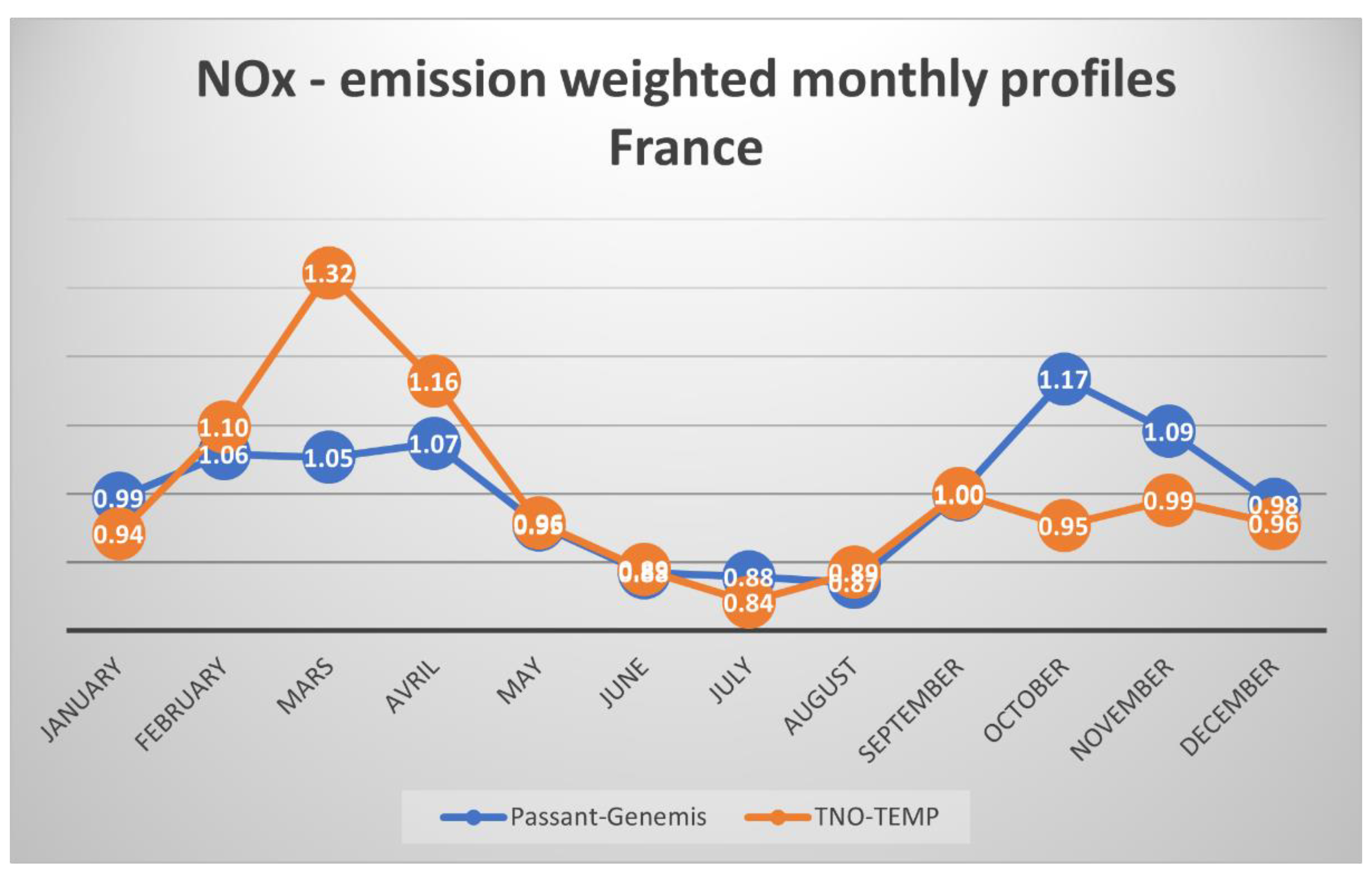
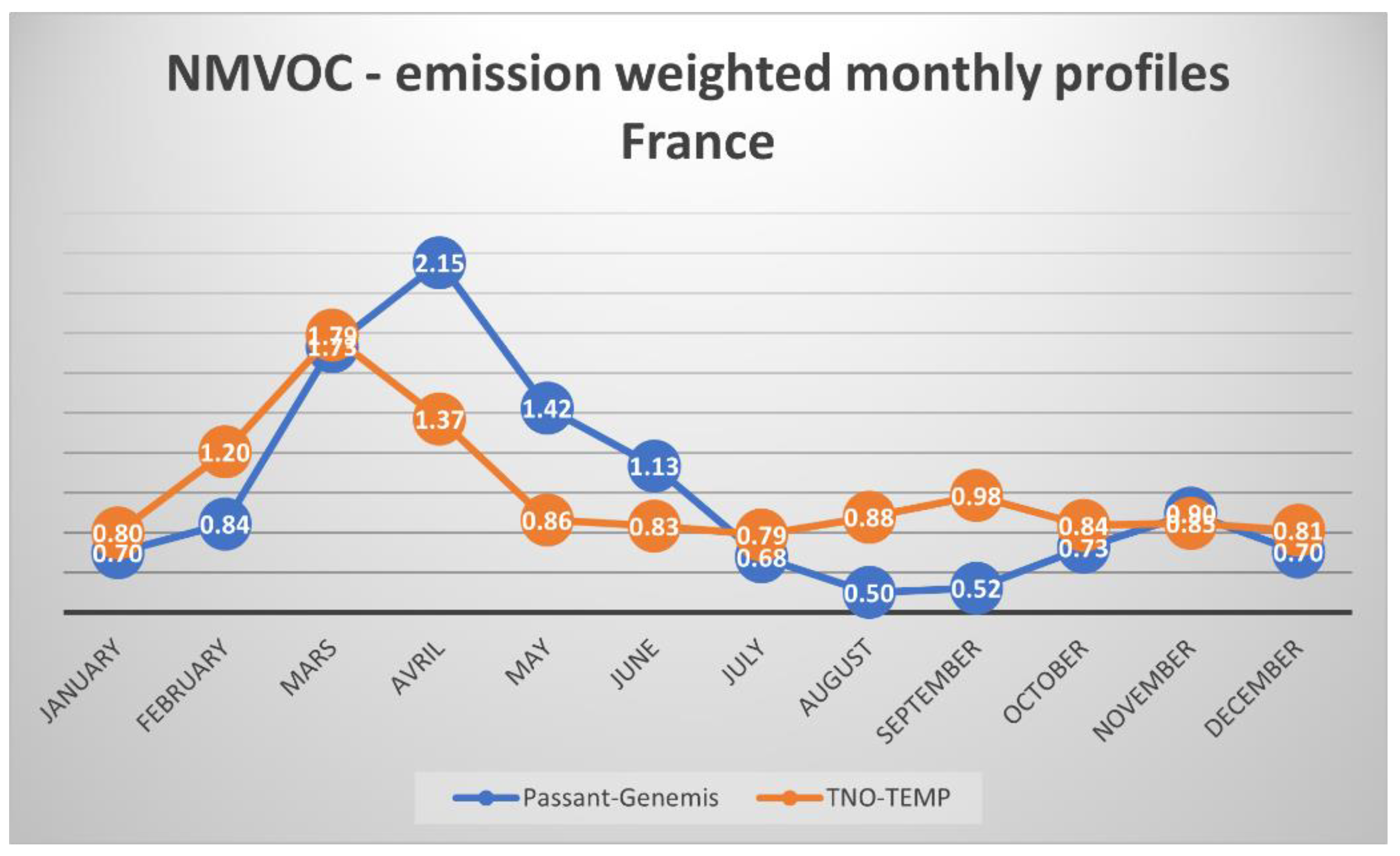
| GNFR13 Sector | NOx Emissions (kT) | NMVOC Emissions (kT) |
|---|---|---|
| A_PublicPower | 26 | 1 |
| B_Industry | 102 | 64 |
| C_OtherStationaryComb | 78 | 106 |
| D_Fugitive | 2 | 21 |
| E_Solvents | 1 | 302 |
| F_RoadTransport | 421 | 47 |
| G_Shipping | 11 | 9 |
| H_Aviation | 10 | 1 |
| I_Offroad | 84 | 21 |
| J_Waste | 2 | 8 |
| K_AgriLivestock | 10 | 196 |
| L_AgriOther | 64 | 202 |
References
- Ambade, B.; Kumar, A.; Latif, M. Emission sources, Characteristics and risk assessment of particulate bound Polycyclic Aromatic Hydrocarbons (PAHs) from traffic sites. 2021. preprint. [Google Scholar] [CrossRef]
- Ambade, B.; Sankar, T.K.; Sahu, L.K.; Dumka, U.C. Understanding sources and composition of black carbon and PM2.5 in urban environments in East India. Urban Sci. 2022, 6, 60. [Google Scholar] [CrossRef]
- Hussain, A.J.; Sankar, T.K.; Vithanage, M.; Ambade, B.; Gautam, S. Black carbon emissions from traffic contribute sustainability to air pollution in urban cities of India. Water Air Soil Pollut. 2023, 234, 217. [Google Scholar] [CrossRef]
- Xu, P.; Chen, Y.; Ye, X. Haze, air pollution, and health in China. Lancet 2013, 382, 2067. [Google Scholar] [CrossRef]
- Solberg, S.; Colette, A.; Raux, B.; Walker, S.-E.; Guerreiro, C. Long-Term Trends of Air Pollutants at National Level 2005–2019; ETC/ATNI Report 2021/9. 2022. Available online: https://www.eionet.europa.eu/etcs/etc-atni/products/etc-atni-reports/etc-atni-report-9-2021-long-term-trends-of-air-pollutants-at-national-level-2005-2019 (accessed on 11 January 2021).
- Directive 2008/50/EC of the European Parliament and of the Council of 21 May 2008 on Ambient Air Quality and Cleaner Air for Europe; Official Journal of the European Union: Luxembourg, 2008.
- Mills, G.; Hayes, F.; Simpson, D.; Emberson, L.; Norris, D.; Harmens, H.; Bueker, P. Evidence of widespread effects of ozone on crops and (semi-) natural vegetation in Europe (1990–2006) in relation to AOT40-and flux-based risk maps. Glob. Chang. Biol. 2011, 17, 592–613. [Google Scholar] [CrossRef]
- Darrow, L.A.; Klein, M.; Sarnat, J.A.; Mulholland, J.A.; Strickland, M.J.; Sarnat, S.E.; Russell, A.G.; Tolbert, P.E. The use of alternative pollutant metrics in time-series studies of ambient air pollution and respiratory emergency department visits. J. Expo. Sci. Environ. Epidemiol. 2011, 21, 10–19. [Google Scholar] [CrossRef]
- Karlsson, P.E.; Sellden, G.; Pleijel, H. Establishing Ozone Critical Levels II. UNECE Workshop Report; U.S. Department of Energy Office of Scientific and Technical Information: Oak Ridge, TN, USA, 2003.
- Lefohn, A.S.; Malley, C.S.; Simon, H.; Wells, B.; Xu, X.; Zhang, L.; Wang, T. Responses of human health and vegetation exposure metrics to changes in ozone concentration distributions in the European Union, United States, and China. Atmos. Environ. 2017, 152, 123–145. [Google Scholar] [CrossRef]
- Monks, P.S.; Archibald, A.; Colette, A.; Cooper, O.; Coyle, M.; Derwent, R.; Fowler, D.; Granier, C.; Law, K.S.; Mills, G. Tropospheric ozone and its precursors from the urban to the global scale from air quality to short-lived climate forcer. Atmos. Chem. Phys. 2015, 15, 8889–8973. [Google Scholar] [CrossRef]
- Simpson, D.; Arneth, A.; Mills, G.; Solberg, S.; Uddling, J. Ozone—The persistent menace: Interactions with the N cycle and climate change. Curr. Opin. Environ. Sustain. 2014, 9, 9–19. [Google Scholar] [CrossRef]
- Real, E.; Megaritis, A.; Colette, A.; Valastro, G.; Messina, P. Atlas of ozone chemical regimes in Europe. Atmos. Environ. 2024, 320, 120323. [Google Scholar] [CrossRef]
- Colette, A.; Rouïl, L.; Meleux, F.; Lemaire, V.; Raux, B. Air Control Toolbox (ACT_v1. 0): A flexible surrogate model to explore mitigation scenarios in air quality forecasts. Geosci. Model Dev. 2022, 15, 1441–1465. [Google Scholar] [CrossRef]
- EEA. Air Quality E-Reporting (AQ e-Reporting); European Environmental Agency: Copenhagen, Denmark, 2019.
- Cuvelier, C.; Thunis, P.; Vautard, R.; Amann, M.; Bessagnet, B.; Bedogni, M.; Berkowicz, R.; Brandt, J.; Brocheton, F.; Builtjes, P.; et al. CityDelta: A model intercomparison study to explore the impact of emission reductions in European cities in 2010. Atmos. Environ. 2007, 41, 189–207. [Google Scholar] [CrossRef]
- Thunis, P.; Rouil, L.; Cuvelier, C.; Stern, R.; Kerschbaumer, A.; Bessagnet, B.; Schaap, M.; Builtjes, P.; Tarrason, L.; Douros, J.; et al. Analysis of model responses to emission-reduction scenarios within the CityDelta project. Atmos. Environ. 2007, 41, 208–220. [Google Scholar] [CrossRef]
- Beekmann, M.; Vautard, R. A modelling study of photochemical regimes over Europe: Robustness and variability. Atmos. Meas. Tech. 2010, 10, 10067–10084. [Google Scholar] [CrossRef]
- Cohan, D.S.; Hu, Y.; Russell, A.G. Dependence of ozone sensitivity analysis on grid resolution. Atmos. Environ. 2006, 40, 126–135. [Google Scholar] [CrossRef]
- Cros, B.; Durand, P.; Cachier, H.; Drobinski, P.; Frejafon, E.; Kottmeier, C.; Perros, P.; Peuch, V.-H.; Ponche, J.-L.; Robin, D. The ESCOMPTE program: An overview. Atmos. Res. 2004, 69, 241–279. [Google Scholar] [CrossRef]
- Mailler, S.; Menut, L.; Khvorostyanov, D.; Valari, M.; Couvidat, F.; Siour, G.; Turquety, S.; Briant, R.; Tuccella, P.; Bessagnet, B. CHIMERE-2017: From urban to hemispheric chemistry-transport modeling. Geosci. Model Dev. 2017, 10, 2397–2423. [Google Scholar] [CrossRef]
- Menut, L.; Bessagnet, B.; Khvorostyanov, D.; Beekmann, M.; Blond, N.; Colette, A.; Coll, I.; Curci, G.; Foret, G.; Hodzic, A.; et al. CHIMERE 2013: A model for regional atmospheric composition modelling. Geosci. Model Dev. 2013, 6, 981–1028. [Google Scholar] [CrossRef]
- Marécal, V.; Peuch, V.-H.; Andersson, C.; Andersson, S.; Arteta, J.; Beekmann, M.; Benedictow, A.; Bergström, R.; Bessagnet, B.; Cansado, A. A regional air quality forecasting system over Europe: The MACC-II daily ensemble production. Geosci. Model Dev. 2015, 8, 2777–2813. [Google Scholar] [CrossRef]
- Colette, A.; Andersson, C.; Baklanov, A.; Bessagnet, B.; Brandt, J.; Christensen, J.H.; Doherty, R.; Engardt, M.; Geels, C.; Giannakopoulos, C. Is the ozone climate penalty robust in Europe? Environ. Res. Lett. 2015, 10, 084015. [Google Scholar] [CrossRef]
- Menut, L.; Bessagnet, B.; Briant, R.; Cholakian, A.; Couvidat, F.; Mailler, S.; Pennel, R.; Siour, G.; Tuccella, P.; Turquety, S.; et al. The CHIMERE v2020r1 online chemistry-transport model. Geosci. Model Dev. 2021, 14, 6781–6811. [Google Scholar] [CrossRef]
- Derognat, C.; Beekmann, M.; Baeumle, M.; Martin, D.; Schmidt, H. Effect of biogenic volatile organic compound emissions on tropospheric chemistry during the Atmospheric Pollution Over the Paris Area (ESQUIF) campaign in the Ile-de-France region. J. Geophys. Res. Atmos. 2003, 108. [Google Scholar] [CrossRef]
- Lattuati, M. Contribution à l’étude du Bilan de l’ozone Troposphérique à l’interface de l’Europe et de l’Atlantique Nord: Modélisation Lagrangienne et Mesures en Altitude. Ph.D. Thesis, Université Paris, Paris, France, 1997. [Google Scholar]
- Granier, C.; Darras, S.; van Der Gon, H.D.; Jana, D.; Elguindi, N.; Bo, G.; Michael, G.; Marc, G.; Jalkanen, J.-P.; Kuenen, J. The Copernicus Atmosphere Monitoring Service Global and Regional Emissions (April 2019 Version); Copernicus Atmosphere Monitoring Service: Bonn, Germany, 2019. [Google Scholar]
- Friedrich, R.; Reis, S. Emissions of Air Pollutants: Measurements, Calculations and Uncertainties; Springer Science & Business Media: Berlin/Heidelberg, Germany, 2004. [Google Scholar]
- Menut, L.; Goussebaile, A.; Bessagnet, B.; Khvorostiyanov, D.; Ung, A. Impact of realistic hourly emissions profiles on air pollutants concentrations modelled with CHIMERE. Atmos. Environ. 2012, 49, 233–244. [Google Scholar] [CrossRef]
- Passant, N. Speciation of UK Emissions of Non-Methane Volatile Organic Compounds; AEA Technology: Carlsbad, CA, USA, 2002. [Google Scholar]
- Guenther, A.; Karl, T.; Harley, P.; Wiedinmyer, C.; Palmer, P.I.; Geron, C. Estimates of global terrestrial isoprene emissions using MEGAN (Model of Emissions of Gases and Aerosols from Nature). Atmos. Chem. Phys. 2006, 6, 3181–3210. [Google Scholar] [CrossRef]
- Hanna, S.R.; Lu, Z.; Frey, H.C.; Wheeler, N.; Vukovich, J.; Arunachalam, S.; Fernau, M.; Hansen, D.A. Uncertainties in predicted ozone concentrations due to input uncertainties for the UAM-V photochemical grid model applied to the July 1995 OTAG domain. Atmos. Environ. 2001, 35, 891–903. [Google Scholar] [CrossRef]
- Moore, G.E.; Londergan, R.J. Sampled Monte Carlo uncertainty analysis for photochemical grid models. Atmos. Environ. 2001, 35, 4863–4876. [Google Scholar] [CrossRef]
- Sillman, S. The relation between ozone, NOx and hydrocarbons in urban and polluted rural environments. Atmos. Environ. 1999, 33, 1821–1845. [Google Scholar] [CrossRef]
- Wild, O. Modelling the global tropospheric ozone budget: Exploring the variability in current models. Atmos. Meas. Tech. 2007, 7, 2643–2660. [Google Scholar] [CrossRef]
- Sharma, S.; Sharma, P.; Khare, M. Photo-chemical transport modelling of tropospheric ozone: A review. Atmos. Environ. 2017, 159, 34–54. [Google Scholar] [CrossRef]
- Schaap, M.; Cuvelier, C.; Hendriks, C.; Bessagnet, B.; Baldasano, J.M.; Colette, A.; Thunis, P.; Karam, D.; Fagerli, H.; Graff, A. Performance of European chemistry transport models as function of horizontal resolution. Atmos. Environ. 2015, 112, 90–105. [Google Scholar] [CrossRef]
- Carter, W.P. Development of the SAPRC-07 chemical mechanism. Atmos. Environ. 2010, 44, 5324–5335. [Google Scholar] [CrossRef]
- Kuenen, J.; Dellaert, S.; Visschedijk, A.; Jalkanen, J.-P.; Super, I.; Denier van der Gon, H. CAMS-REG-v4: A state-of-the-art high-resolution European emission inventory for air quality modelling. Earth Syst. Sci. Data Discuss. 2021, 2021, 1–37. [Google Scholar]
- Kuenen, J.; Denier van der Gon, H.; Visschedijk, A.; Van der Brugh, H.; Van Gijlswijk, R. MACC European Emission Inventory for the Years 2003–2007; NO-report TNO-060-UT-2011-00588; TNO: Utrecht, The Netherlands, 2011.
- Bessagnet, B.; Cuvelier, K.; de Meij, A.; Monteiro, A.; Pisoni, E.; Thunis, P.; Violaris, A.; Kushta, J.; Denby, B.R.; Mu, Q. Assessment of the sensitivity of model responses to urban emission changes in support of emission reduction strategies. Air Qual. Atmos. Health 2023, 1–26. [Google Scholar] [CrossRef]
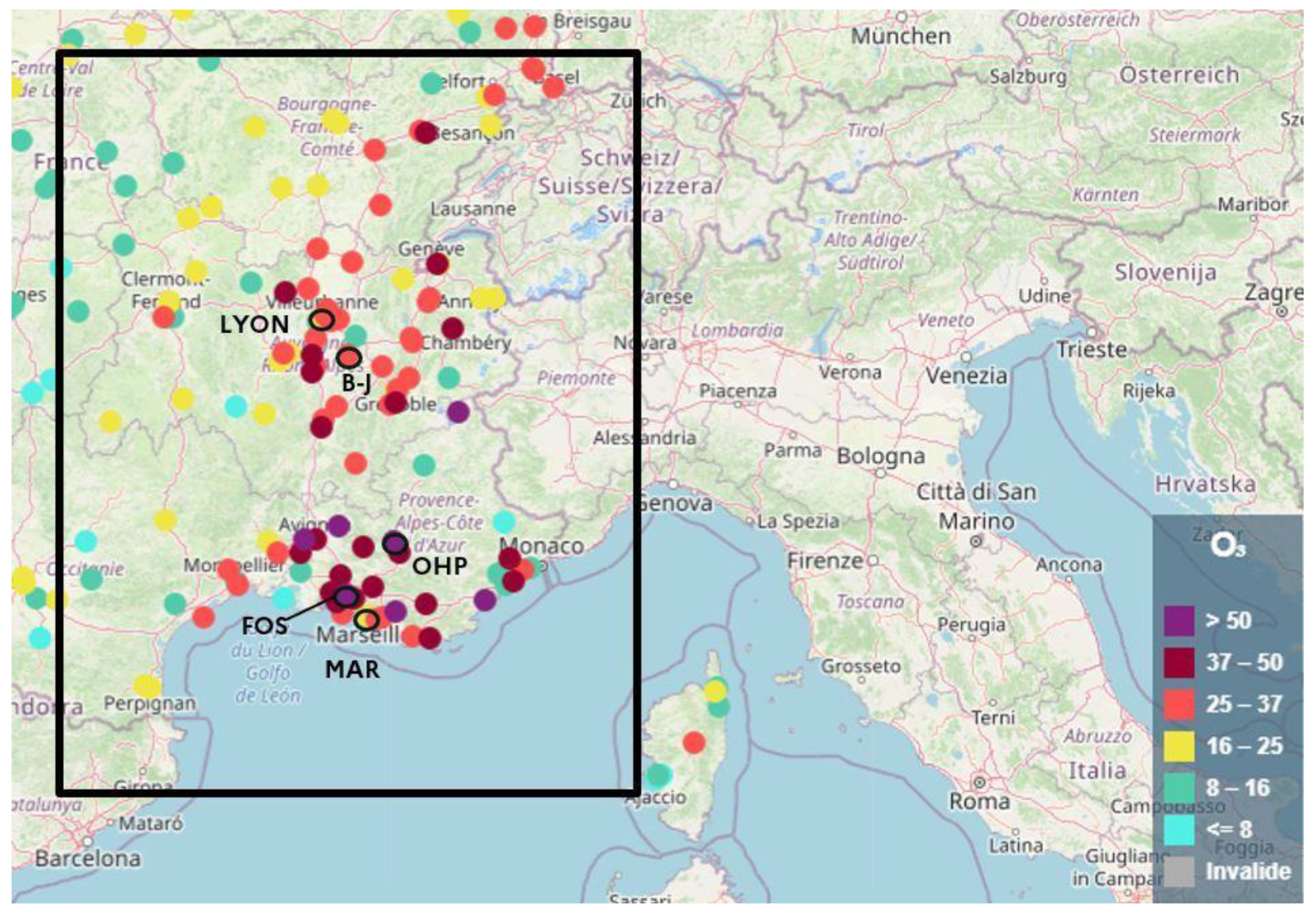
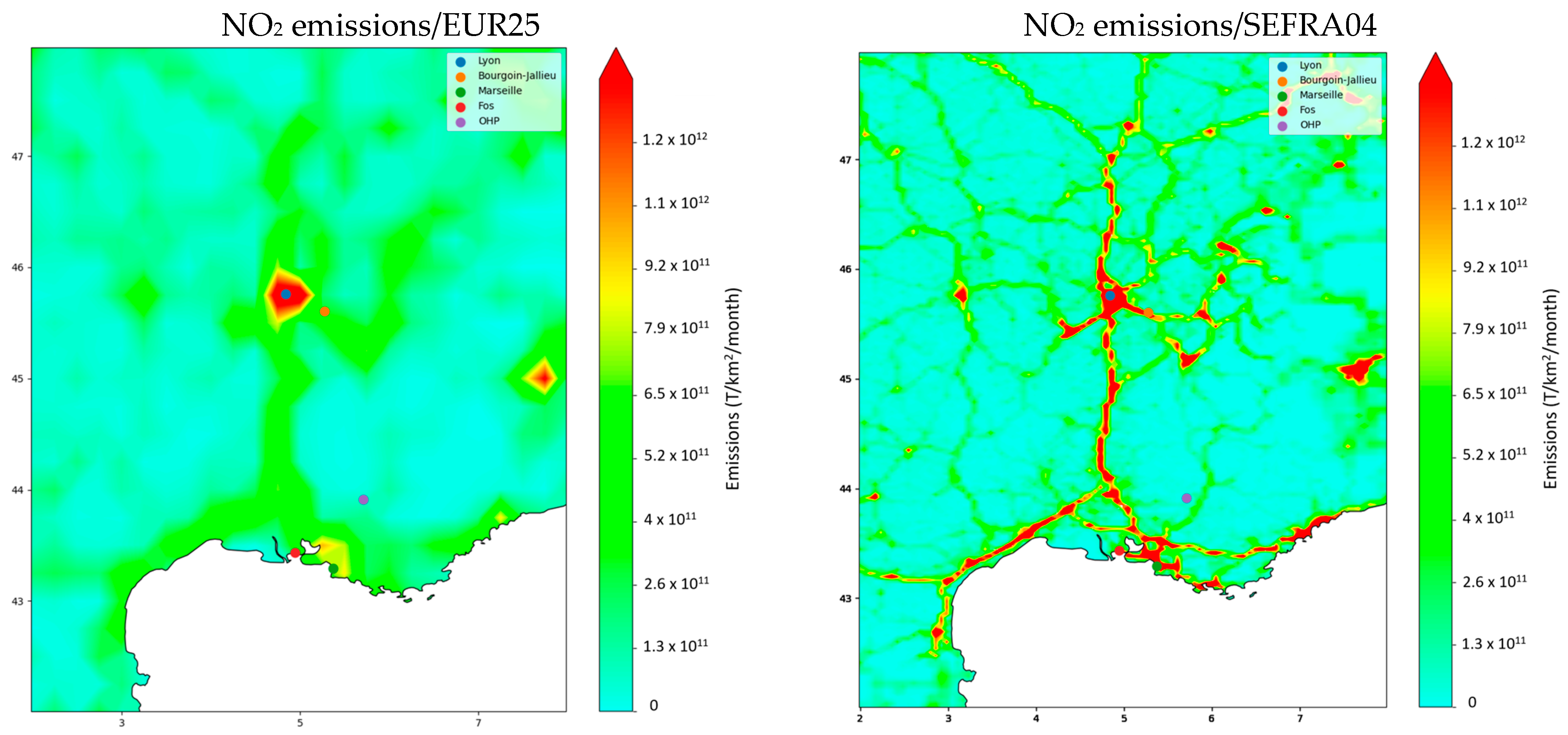

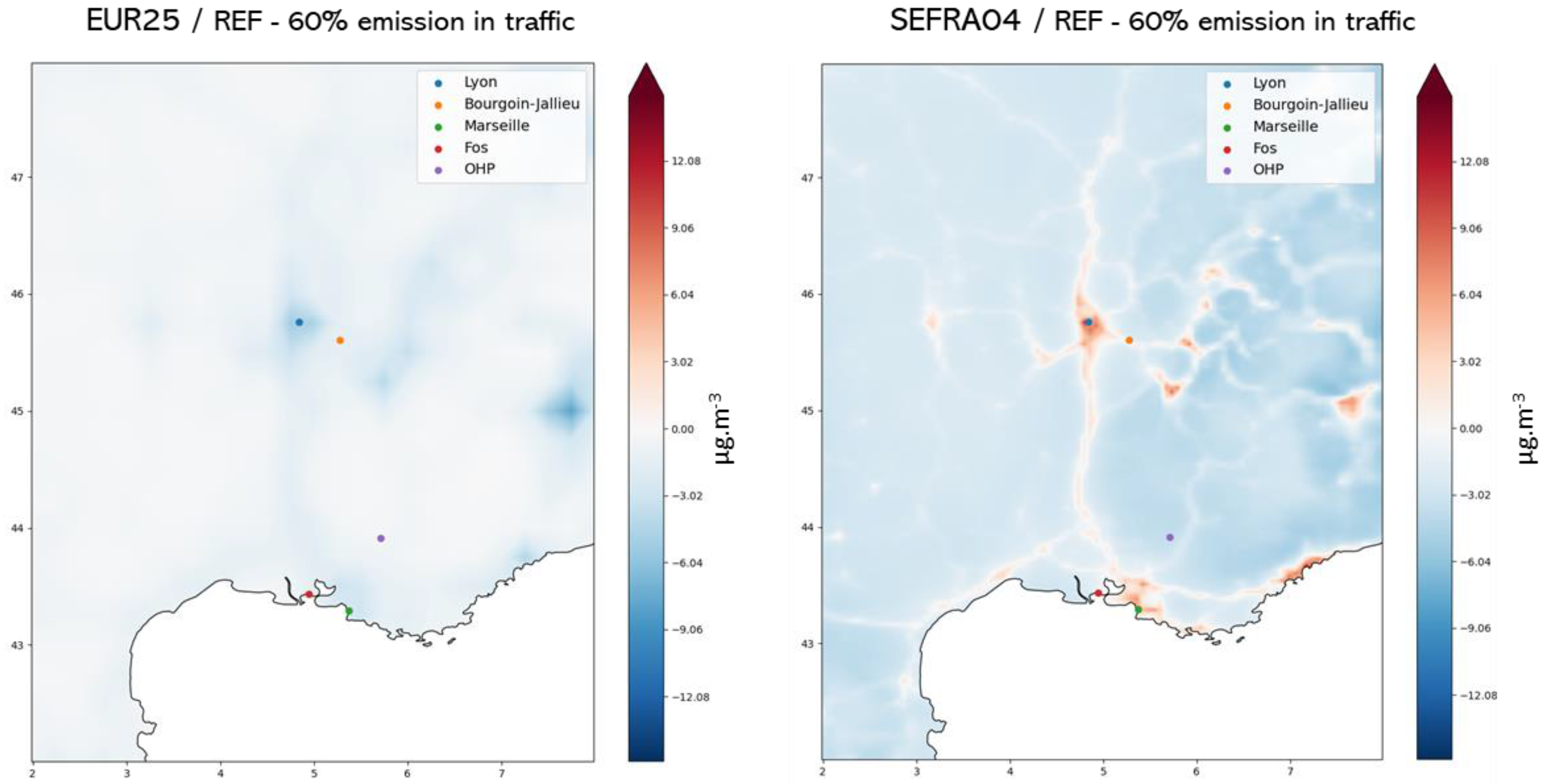
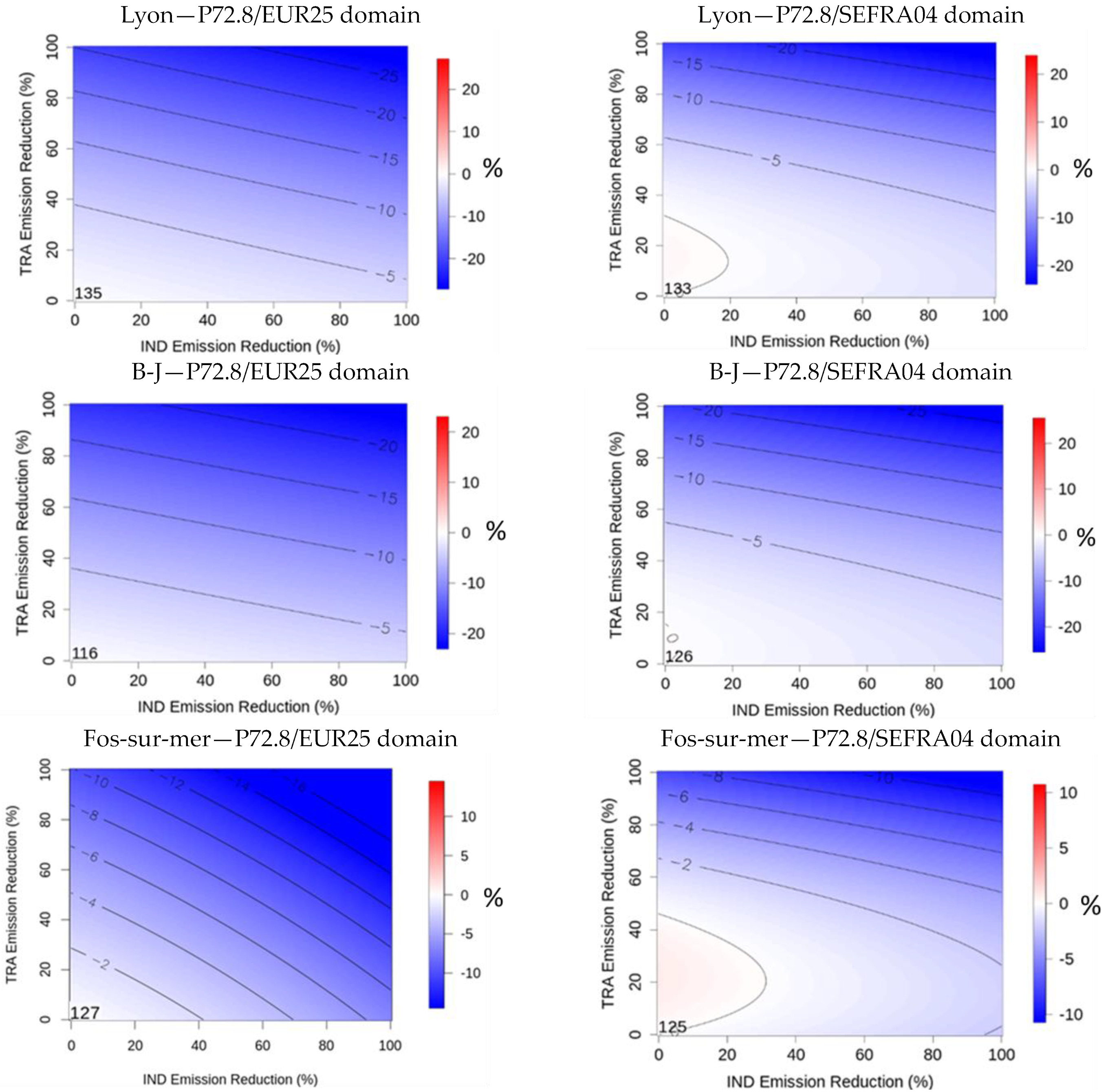

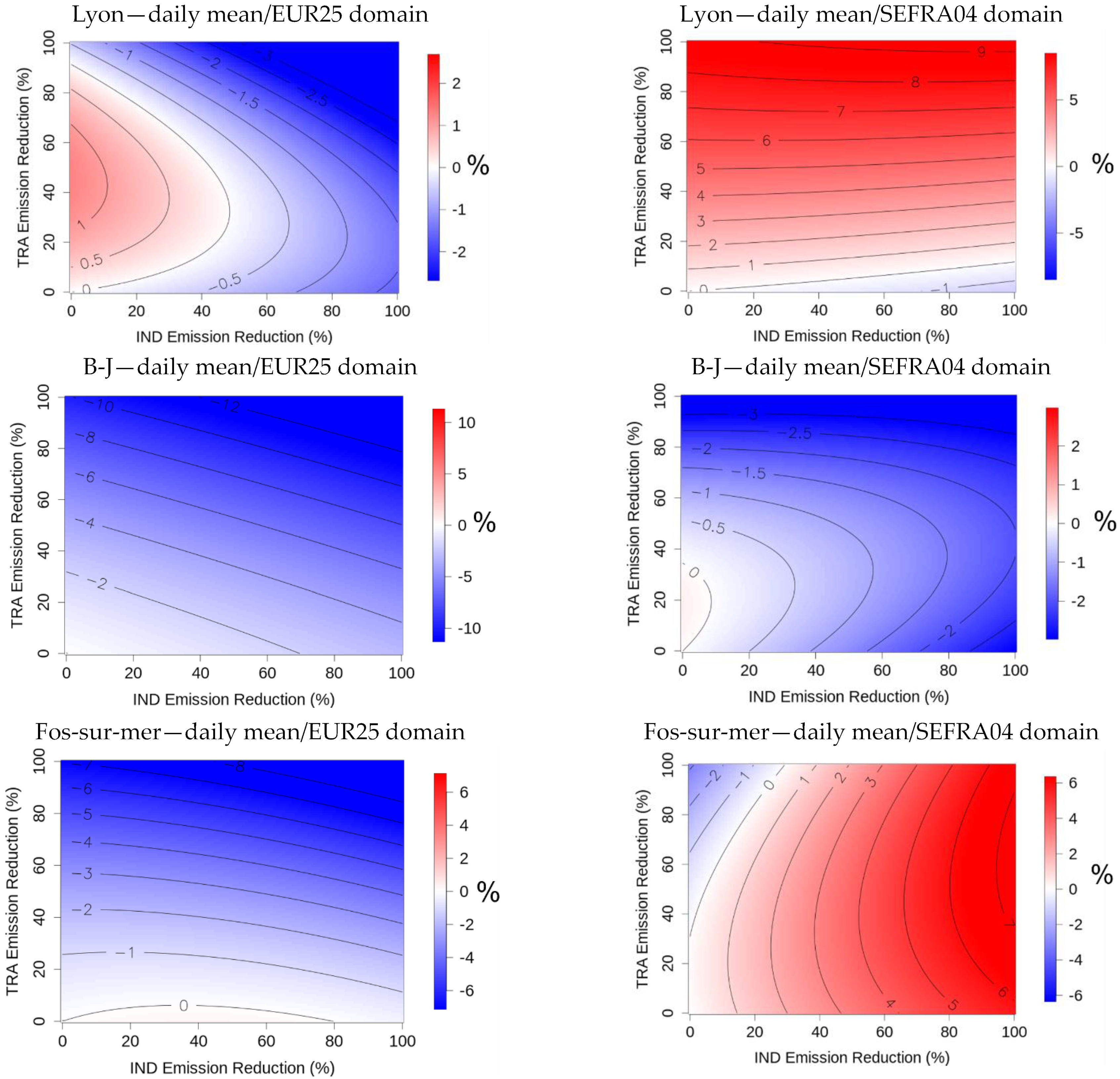




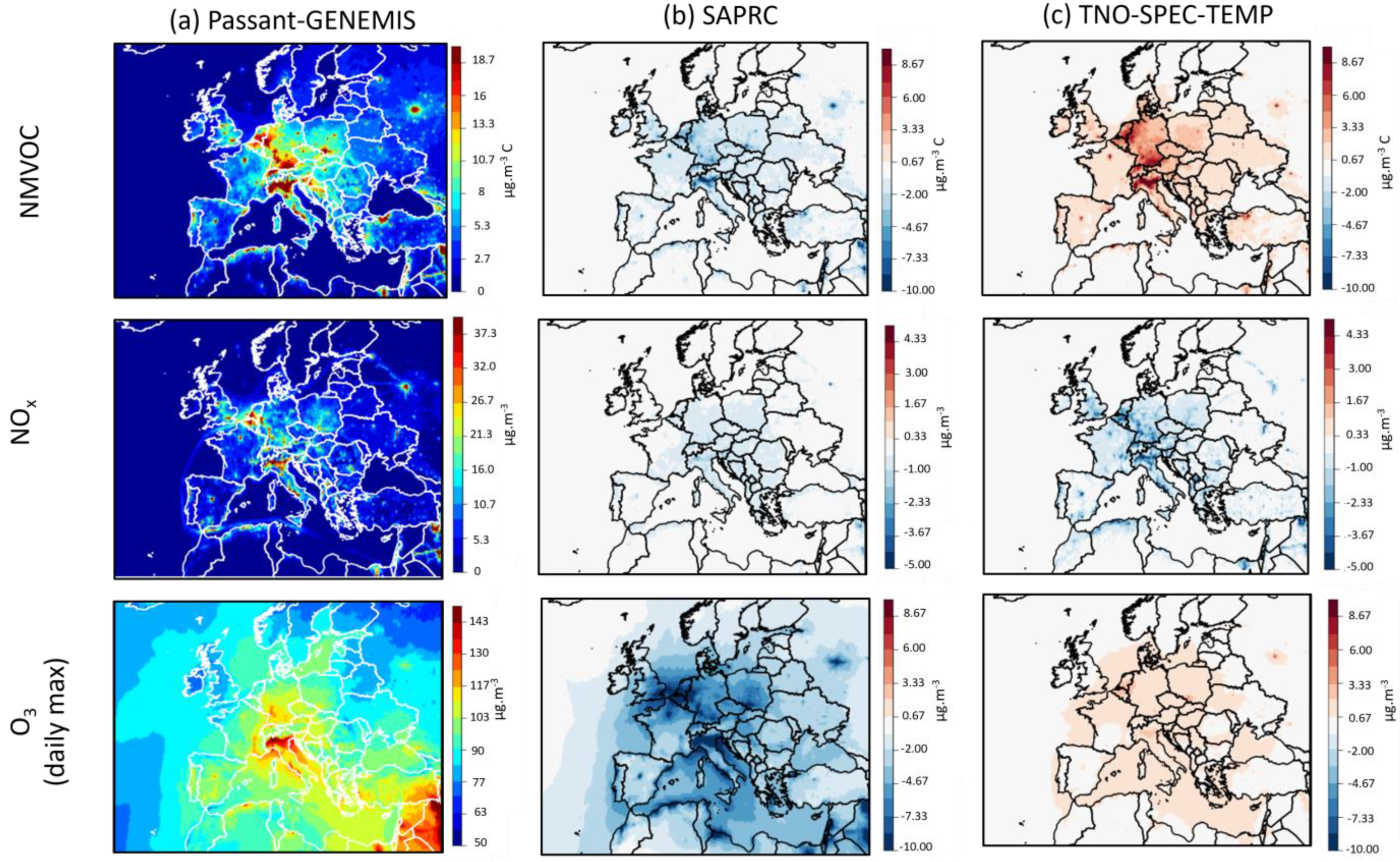
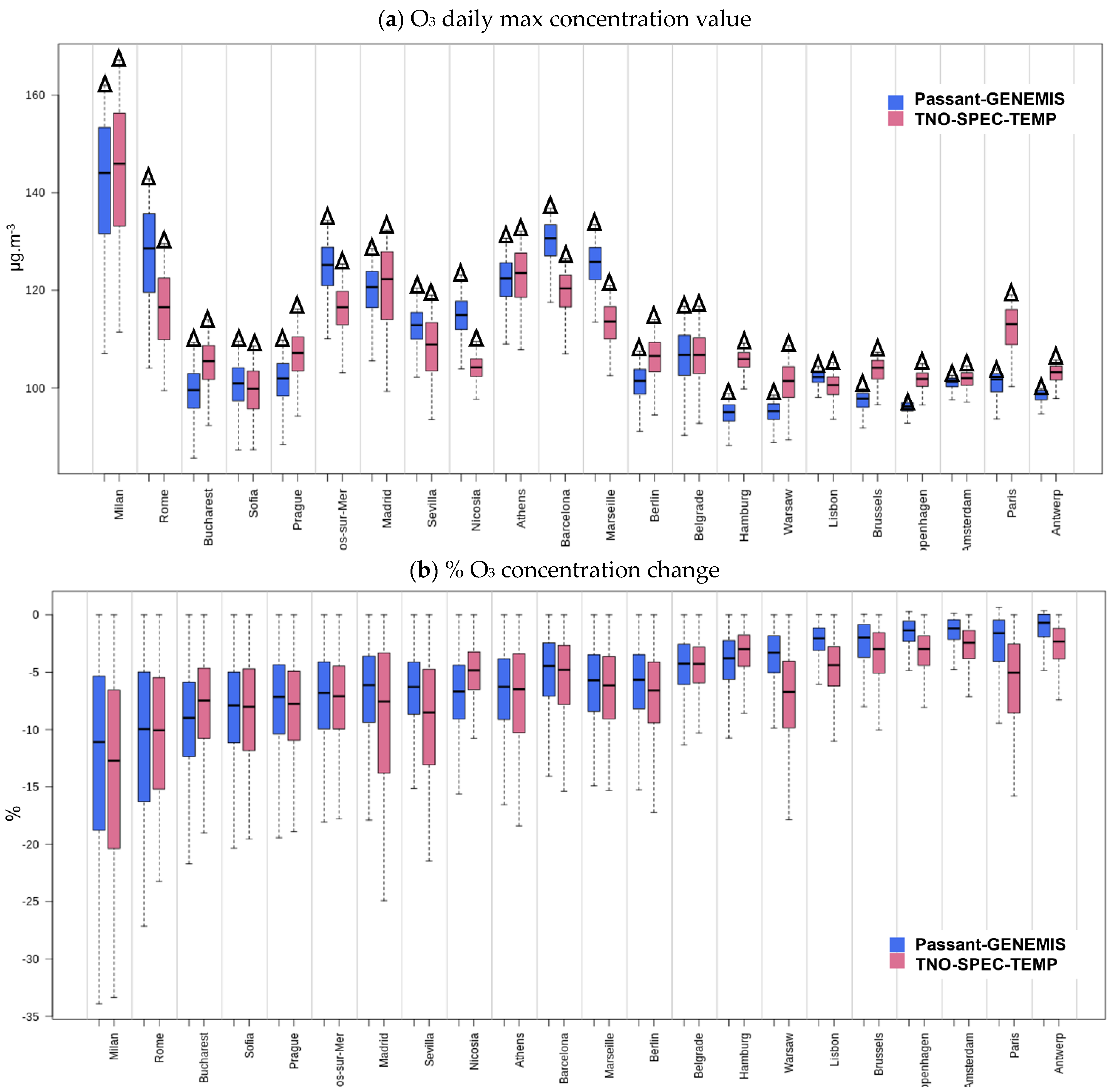
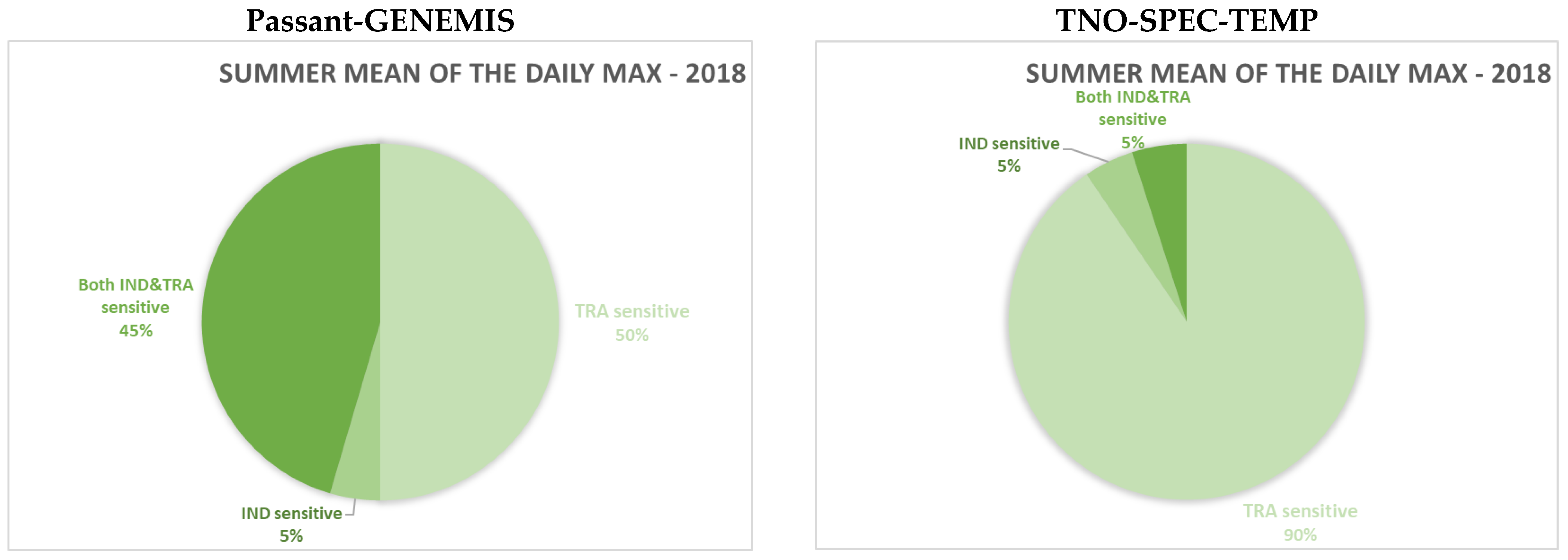
| REF (EUR25 or Passant-GENEMIS) | SEFRA04 (or BC-EUREF) | BC-EURED | TNO-SPEC-TEMP | |
|---|---|---|---|---|
| Annual Emission | CAMS-REG v3.1 inventory for year 2018 | CAMS-REG v3.1 inventory for year 2018 | CAMS-REG v3.1 inventory for year 2018 | CAMS-REG v3.1 inventory for year 2018 |
| Meteo | IFS (ECMWF) | IFS (ECMWF) | IFS (ECMWF) | IFS (ECMWF) |
| Domain | Europe | South-East France | South-East France | Europe |
| Horizontal resolution | 25 × 25 km | 4 × 4 km | 4 × 4 km | 25 × 25 km |
| Boundary Condition | IFS Global model | REF (EUR25) run with the same emission reductions | REF (EUR25) without emission reductions | IFS Global model |
| Chemical mechanism | Melchior 2 | Melchior 2 | Melchior 2 | Melchior 2 |
| Emission VOC speciation | Passant | Passant | Passant | TNO (CAMS-REG) |
| Temporal profiles | GENEMIS | GENEMIS | GENEMIS | TNO (CAMS-REG) |
| O3 Daily Max | |||
| Bias | R | RMSE | |
| EUR25 | −3.8 | 0.79 | 18.53 |
| SEFRA | −1.0 | 0.76 | 18.43 |
| O3 Daily Mean | |||
| Bias | R | RMSE | |
| EUR25 | 5.9 | 0.77 | 23.9 |
| SEFRA | 4.9 | 0.75 | 24.0 |
| Sharma et al., 2017 ([37]) | 8.4 | 0.62 | 29.0 |
| Chemical Mechanism | VOC Speciation | Temporal Profiles | |
|---|---|---|---|
| Passant-GENEMIS | Melchior 2 ([26]) | Passant ([31]) | GENEMIS ([29]) |
| TNO-SPEC | Melchior 2 ([26]) | TNO (CAMS-REG) | GENEMIS ([29]) |
| TNO-TEMP | Melchior 2 ([26]) | Passant ([31]) | TNO (CAMS-REG) |
| TNO-SPEC-TEMP | Melchior 2 ([26]) | TNO (CAMS-REG) | TNO (CAMS-REG) |
| SAPRC | SAPRC ([39]) | Passant ([31]) | GENEMIS ([29]) |
| Passant-GENEMIS | TNO-SPEC-TEMP | TNO-SPEC | TNO-TEMP | SAPRC | |
|---|---|---|---|---|---|
| Mean Bias | −8.70 | −6.09 | −7.73 | −7.25 | −9.39 |
| R2 | 0.78 | 0.78 | 0.78 | 0.77 | 0.77 |
| RMSE | 19.87 | 18.61 | 19.34 | 19.15 | 20.14 |
Disclaimer/Publisher’s Note: The statements, opinions and data contained in all publications are solely those of the individual author(s) and contributor(s) and not of MDPI and/or the editor(s). MDPI and/or the editor(s) disclaim responsibility for any injury to people or property resulting from any ideas, methods, instructions or products referred to in the content. |
© 2024 by the authors. Licensee MDPI, Basel, Switzerland. This article is an open access article distributed under the terms and conditions of the Creative Commons Attribution (CC BY) license (https://creativecommons.org/licenses/by/4.0/).
Share and Cite
Real, E.; Couvidat, F.; Chantreux, A.; Megaritis, A.; Valastro, G.; Colette, A. Assessing the Robustness of Ozone Chemical Regimes to Chemistry-Transport Model Configurations. Atmosphere 2024, 15, 532. https://doi.org/10.3390/atmos15050532
Real E, Couvidat F, Chantreux A, Megaritis A, Valastro G, Colette A. Assessing the Robustness of Ozone Chemical Regimes to Chemistry-Transport Model Configurations. Atmosphere. 2024; 15(5):532. https://doi.org/10.3390/atmos15050532
Chicago/Turabian StyleReal, Elsa, Florian Couvidat, Adrien Chantreux, Athanasios Megaritis, Giuseppe Valastro, and Augustin Colette. 2024. "Assessing the Robustness of Ozone Chemical Regimes to Chemistry-Transport Model Configurations" Atmosphere 15, no. 5: 532. https://doi.org/10.3390/atmos15050532





